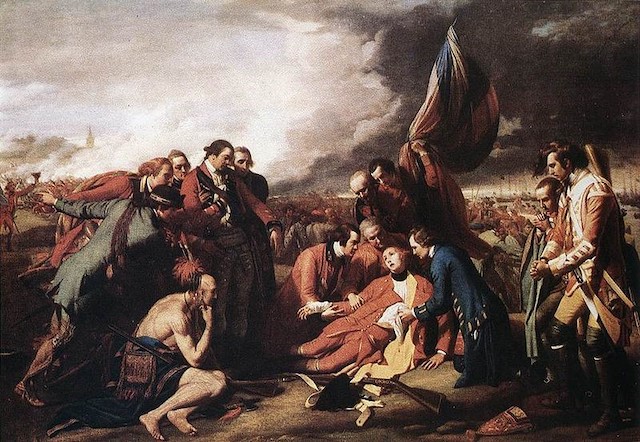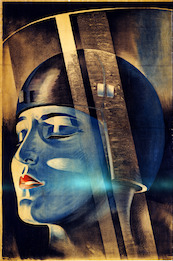The past is prologue. The stories we tell about ourselves and our forebears inform the sort of country we think we are and help determine public policy. As our previous president promised to “Make America great again,” this moment is an appropriate time to reconsider our past, look back at various eras of United States history and re-evaluate America’s origins. When, exactly, were we “great”?

“The Death of General Wolfe” (1770) by Benjamin West. In this scene from the French and Indian War, the artist—a colonist—depicts in the sky the light of British conquest overcoming the dark clouds of French rule in Canada.
If Americans have heard of the Seven Years’ War – a truly global struggle – it is most certainly under the title “The French and Indian War” (1754-1763). Popular images of the conflict are likely to stem from the 1992 movie “The Last of the Mohicans,” starring Daniel Day-Lewis. When Americans think of this war at all, or discuss it in school, they generally situate the central theater of the conflict in the northeast of North America. Yes, the savage Indians and their deceitful French allies were beaten back along the wooded frontier, allowing pacific English – soon to be American – farmers to live in peace. Ending in 1763, and saddling Britain with debt, the French and Indian War is often remembered as but a prelude to a coming colonial revolt over excessive taxation. Perhaps it was, but not in a direct, linear sense. Nothing historical is preordained. Chance and contingency ensure as much.
In reality, though the fighting began in North America – western Pennsylvania to be exact – the American theater (just like the simultaneous campaigns in India) was often a sideshow to the main event unfolding in Europe. That was a global war, fought on several continents between Britain and Prussia on one side and France, Russia and Austria on the other. It’s important to remember that events in America – then and now – did not unfold in a vacuum but rather shaped and were shaped by global affairs. And, while it is true the American Revolution kicked off just a dozen years after the Treaty of Paris ended the Seven Years’ War, nothing about the revolt was inevitable. In fact, in 1763, at the close of the French and Indian War, the vast majority of colonists saw themselves as Englishmen and Englishwomen, invested in and proud of their British Empire.
How to Kick Off a Global War
It started over land, and money. The “Ohio Country,” just west of the Appalachian Mountains, covered much of what is today the state of Ohio, western Pennsylvania and West Virginia. Rich in lumber, with fertile farmland and plentiful game, the Ohio Country presented a tempting find. Though mainly inhabited by native tribes, the region also just happened to sit on the contested border between France and Britain’s empires in North America.
Both sides (and, no doubt, the native inhabitants) coveted this land. The French saw the Ohio Country as a strategic buffer against the encroaching Brits, and to the Indians, well, it was home. The English settler population of the 13 Colonies was, however, rapidly expanding westward. The stage was set for conflict. All it took was the right spark. Count on the profit motive as a reliable catalyst.
A few decades earlier, some prominent Virginia families, including those of both the royal governor and a young militia officer named George Washington, established the Ohio Company of Virginia. This being a land speculation outfit at heart, the company’s investors hoped to claim land in the Ohio Country, buy it cheaply from the Crown and sell at a profit to westward-bound settlers. Buy low, sell high – enrich the already wealthy plantation families of Virginia – same old game!
So, when the time came to seize and hold the land in western Pennsylvania once and for all, guess who Robert Dinwiddie, lieutenant governor of Virginia – himself an Ohio Company investor – sent in? A young lieutenant colonel of the militia, George Washington. Washington took a militia company and some allied Mingo Indians and headed toward Fort Duquesne, a French installation near present-day Pittsburgh. The French command sent out from the fort a smaller party under Joseph de Jumonville, with strict orders to avoid a fight unless provoked.
What happened next is contested in the few existing accounts. The most credible sources agree that Washington’s force surrounded the French party and opened fire, killing several. Most surrendered, however, at which point Washington’s native counterpart, known as the “Half King” wielded a tomahawk to Jumonville’s head, killing the Frenchman. This was supposed to have been as much a diplomatic as a military mission, and no state of war had been declared. Washington’s choice to open fire was strategically and ethically questionable; however, his inability to control his native allies and the assassination of a prisoner must certainly constitute a war crime.
Early Setbacks, Stillborn Unity
Things didn’t go so well for the British early on. Despite exponentially outnumbering the military and settler population of New France, the Brits and their colonists suffered some disconcerting early defeats. Soon after the “Jumonville Affair,” the French dispatched hundreds of troops and allied natives to dislodge Washington’s force, which had built a ramshackle defense known as “Fort Necessity.” A military novice in his 20s, Washington placed his fort in an indefensible location and was forced to humiliatingly surrender.
Soon after, a large British column commanded by Gen. Edward Braddock was ambushed and nearly destroyed, and Braddock was killed. Washington, barely escaping several near misses, would experience his second consecutive defeat in battle. For the next few years, the British knew mostly defeat and the colonists suffered under brutal French and Indian raids up and down the western frontier.
As the settlers’ confidence deteriorated under the weight of defeats and frontier insecurity, some leaders began to argue for increased colonial unity as a desperate, defensive panacea. Representatives from the various colonies met in Albany, New York, to discuss the prospect of confederation. The result was disappointing. Although it is true that the first colloquial usage of the term “American” seems to have begun in this period, the diverse and fiercely independent colonies were – despite the vicious frontier attacks – not yet ready for unification. Little was settled, less was agreed to. Contrary to the deterministic interpretations of the French and Indian War as a prelude to the American Revolution, the fact is that individual colonial identities were far too strong and the threat from France and the Indians far too uneven to prompt any meaningful confederation.
Celebrating Empire
By 1759, the tide began to turn. The British, under the governmental leadership of William Pitt, changed strategy and responded to French onslaughts in clever ways. The British already had massive advantages in colonial manpower and naval power. Now, they began to follow the French lead and recruit their own Native American allies. The British bankrolled the Prussians under Frederick the Great to do the heavy lifting of ground battle on the European continent and shifted resources to the colonial theaters in India, the Caribbean and North America. The Brits also imposed an effective naval blockade on New France (roughly analogous to modern Canada) to cut off French reinforcements.
After Gen. James Wolfe (depicted in the painting at the top of this article) famously defeated the French on the Plains of Abraham outside Quebec, momentum clearly shifted to the British. Though this is indeed remembered as the seminal battle of the French and Indian War, one could just as plausibly argue the French actually lost Canada – and the Seven Years’ War – in a battle fought in modern Poland on the European continent. Such was the global, interconnected nature of warfare, even in the 18th century.
How, then, did the English colonists view themselves and define their identity in the wake of British victory? Were they indeed the unified Americans on the cusp of independence, as is so often remembered? Hardly.
Sometimes a painting, a period work of art, has much to impart to the observant historian. The artist who created “The Death of General Wolfe,” Benjamin West, was a colonist, an “American,” from Pennsylvania, in fact. West’s painting was a hit, paraded around the London Royal Academy after its completion. So what, exactly, did West hope to communicate with his famous painting? Pride. In victory and in empire. In the sky he depicts the light of British conquest overcoming the dark clouds of French rule in Canada. A Native American, clearly of a British-allied tribe, crouches in stereotypical dress and in the reflective pose of a truly “noble savage.” And, at center, there is the martyred Gen. Wolfe, held by his comrades in the ubiquitous Christ-like “lamentation” pose (see below) of so many famous Western religious depictions. Here was the new Christ, a general, a British general who sacrificed so America could be free (of the French and their native allies, that is).

“The Lamentation Over the Dead Christ” (c. 1600-1604) by Abraham Janssens.
West, the Pennsylvania colonist, memorialized the French and Indian War not as a prelude to independence but as a celebration of empire, British empire. At the close of this brutal, costly war (2.5 percent of the men of Boston had been killed), West and most other American colonists did indeed share a common identity of sorts: as proud Britons.
An Unhappy Peace: Conflicting Lessons, Divergent Expectations
“Peace will be as hard to make as war.” ~ William Pitt (1759)
Both the colonists and metropolitan Britons emerged from the long, vicious conflagration with contrasting expectations. As is so often the case, many of these desires ran at cross-purposes. The British imperial officials wanted, most of all, to consolidate their gains (France had ceded all of Canada and the Ohio Valley) and ensure stability.
Above all, this meant protecting the newly gained territory and separating English settlers from the native tribes west of the Appalachian Mountains. Toward the end of the war, a confederation of Ohio Country Indian tribes realized the French were losing and they would probably soon find themselves alone to check the expansionist Brits. The crisis of extended war and impending French defeat begot a spiritual awakening among the natives led by a holy man named Neolin.
Neolin’s call for native unity influenced an Ottawa war chief known as Pontiac to attack British forts up and down the frontier in a conflict that took his name, Pontiac’s Rebellion. Though the British eventually prevailed, they incurred heavy casualties, and the demonstration of native unity had spooked imperial officials. To avoid a repeat rebellion and preserve the status quo, the British announced the Proclamation Line of 1763, which ceded land west of the Appalachians to the Ohio Country tribes and forbade further settler expansion. They also hoped to raise funds from the (presumably grateful) colonists to help pay down Britain’s crippling war debts. That meant taxes—and taxes, eventually, meant discord.
None of that jibed with colonists’ expectations. They had started the war—for land, for expansion, for profit! How, then, could their British protectors deny them their destiny: ample farmland and security from native savages across the Appalachians. They, too, had fought in the key battles of the conflict, as militiamen alongside the British redcoats. Nor did most colonists expect to bear the burden of debt relief for the crown: Hadn’t they already borne the brunt of a war fought adjacent to their land and endured Indian raids on their homesteads? The stage, so to speak, was set for future confrontation.
The Real Losers: Dwindling Hope for Native Empowerment
If colonial and metropolitan Britons emerged from the war with divergent lessons and expectations, so too did the local native tribes. The Ohio Country, which the French had ceded without native permission, was the tribes’ home. Pontiac’s Rebellion demonstrated just how serious the Indian claims were. Nonetheless, unsurprisingly, the natives proved to be the war’s great victims.
For years, decades even, native tribes had counted on the imperial rivalries between British, French and Spanish claimants to North America as a way to divide, conquer and survive. Though the Indians were generally weaker than the great European empires, they had become adept at balancing between the differing poles of imperial power and played the part of spoiler in countless colonial wars. Now, with New France vanquished and the Spanish empire increasingly anemic, the native tribes could no longer rely on tried and true past strategies. They stood alone in the face of a powerful, populous and insatiably expansionist British Empire. Pontiac’s Rebellion was a desperate response to the new reality, but the more prescient chiefs could see the tragic writing on the wall.

“General Johnson Saving a Wounded French Officer From the Tomahawk of a North American Indian” (c. 1764-68), by Benjamin West.
Some Indians must no doubt have felt expendable as the French abandoned them to their fate. Could natives ever truly trust any Europeans? In the end, were these white men not all cut from the same cloth, as they arrogantly traded Indian land as spoils in a deadly imperial game?
Consider the above painting – also by colonist Benjamin West – in which a “civilized” British officer restrains his “savage” ally from killing their ostensibly common enemy. The message is instructive: Yes, the French were their foes, but both (European) sides at least adhered to common rules of gentlemanly warfare. View this painting out of context and it is far from obvious that the red- and white-clad Caucasians are actually enemies. Viewed through the lens of Benjamin West, it seems the real enemy of civilization is the “savage” – that anachronistic native who most certainly has no place in the North American future. Though many Native Americans surely couldn’t yet foresee it, they were already doomed. It was they, not the French, who had truly lost the Seven Years’ War!
* * *
In 1763, American colonists felt little sense of – the term was yet to be coined – common nationalism. Despite contemporary memories to the contrary, in the coming revolution against Britain the colonists hardly rebelled against the concept of empire itself. Rather, they desired a new, expansive American Empire, unhindered by London and stretching west over the Appalachians and deep into native lands. If the Seven Years’ or “French and Indian” War was the first conflict for North American empire, well, then, perhaps it helped set the stage for the second: the American War for Independence.
Of course, all attempts by historians – this author included – to periodize and categorize the past run the risk of determinism and distort the inherent contingency of events. Still, a fresh look at the French and Indian War raises profound questions about the course of early American history. It is, perhaps, appropriate to exchange the standard narrative of these events for something at once more accurate and, for many, more disturbing. Instead of a simple prelude to the coming revolution, couldn’t it be that the Seven Years’ War was itself a pivotal turning point in American history – the moment when the balance shifted and native power irreversibly waned? If so, it is long past time to replace the comforting American narrative of a transition from (British) empire to liberal republic with a more accurate and complex progression: from empire to revolution to a new, American empire – We live in it still.
For further information on this topic, consider the following sources:
● Fred Anderson, “Crucible of War: The Seven Years’ War and the Fate of Empire in British North America, 1754-1766.”
● Alan Taylor, “American Colonies: The Settling of North America.”
● James West Davidson, et al., editor, “Experience History: Interpreting America’s Past,” 7th edition, Chapter 6.
Written by Maj. Danny Sjursen for TruthDig ~ March 3, 2018
~ Author ~
Maj. Danny Sjursen is a retired U.S. Army officer and former history instructor at West Point. He served tours with reconnaissance units in Iraq and Afghanistan…
The views expressed in this article are those of the author, expressed in an unofficial capacity, and do not reflect the official policy or position of the Department of the Army, Department of Defense, or the U.S. government.
 FAIR USE NOTICE: This site contains copyrighted material the use of which has not always been specifically authorized by the copyright owner. We are making such material available in our efforts to advance understanding of environmental, political, human rights, economic, democracy, scientific, and social justice issues, etc. We believe this constitutes a ‘fair use’ of any such copyrighted material as provided for in section 107 of the US Copyright Law. In accordance with Title 17 U. S. C. Section 107, the material on this site is distributed without profit to those who have expressed a prior interest in receiving the included information for research and educational purposes. For more information go to: http://www.law.cornell.edu/uscode/17/107.shtml
FAIR USE NOTICE: This site contains copyrighted material the use of which has not always been specifically authorized by the copyright owner. We are making such material available in our efforts to advance understanding of environmental, political, human rights, economic, democracy, scientific, and social justice issues, etc. We believe this constitutes a ‘fair use’ of any such copyrighted material as provided for in section 107 of the US Copyright Law. In accordance with Title 17 U. S. C. Section 107, the material on this site is distributed without profit to those who have expressed a prior interest in receiving the included information for research and educational purposes. For more information go to: http://www.law.cornell.edu/uscode/17/107.shtml
